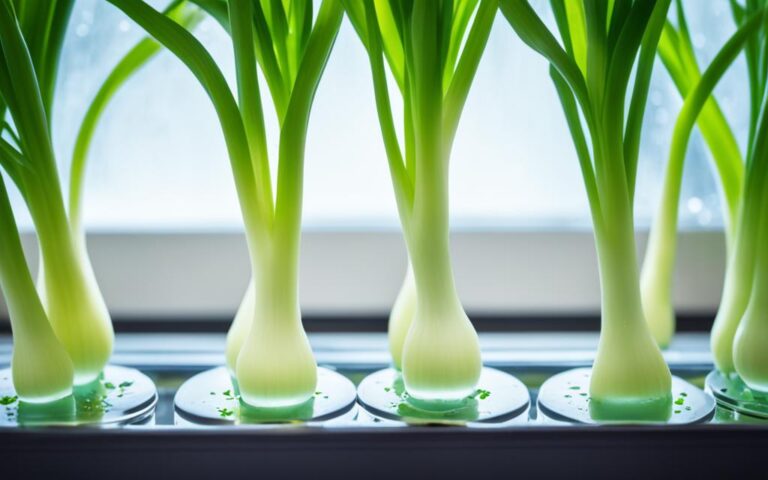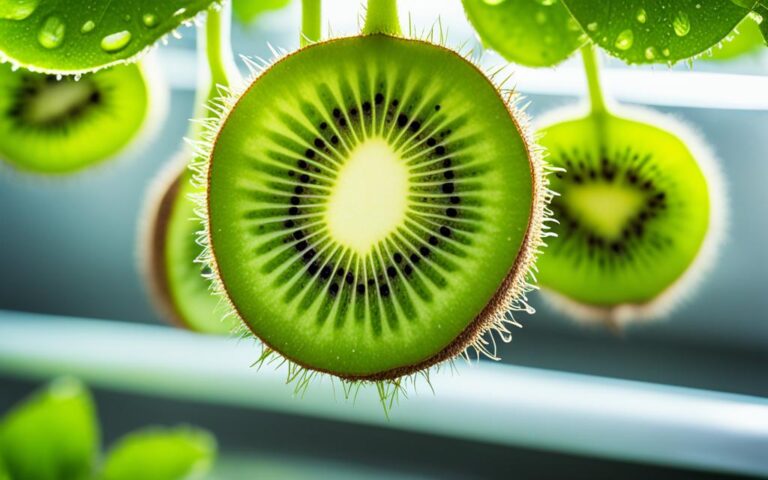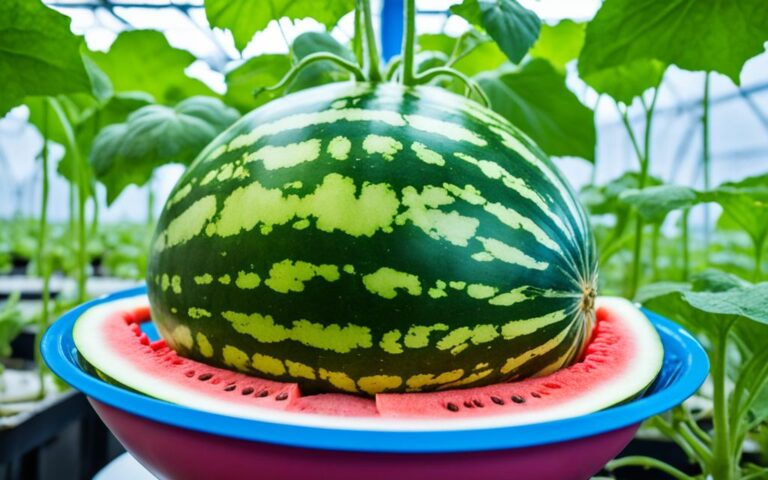Grow Hydroponic Rosemary: Indoor Gardening Tips
Rosemary is a plant well-loved for its smell and taste. It grows great in water systems, especially the Nutrient Film Technique (NFT). If you love growing plants indoors and want to try herbs, rosemary is a good choice. This guide will show you how to do it. We’ll cover the best types of rosemary, how to set everything up, and how to feed your plants for the best growth.
Key Takeaways
- Rosemary adapts well to hydroponic gardening systems, especially using the NFT method.
- Key varieties include Rosmarinus officinalis, ‘Prostratus’, ‘Golden Rain’, and ‘Blue Spires’.
- Health benefits of rosemary include antioxidant and anti-inflammatory properties.
- Successful growth can be achieved by using rockwool as a growing medium and planting multiple seeds per pod.
- Ensuring proper nutrient management and pH levels is crucial for optimal growth.
Table of Contents
Introduction to Hydroponic Rosemary
Hydroponic rosemary is all about growing Rosmarinus officinalis, or simply rosemary, without soil. It’s become a favorite method for indoor gardeners. They love it for the stronger aroma and taste of the herbs it produces. For success, you need a solid hydroponic setup and the right materials to feed and support the plants.
What is Hydroponic Rosemary?
Hydroponic rosemary means growing rosemary plants without soil. Instead, their roots get nutrients from a water solution. This method can use different techniques like the Nutrient Film Technique (NFT), Deep Water Culture (DWC), or drip systems. These techniques help keep the plants healthy, resulting in more effective growth and bigger yields. Plus, hydroponics uses less water, so it’s better for the planet.
Hydroponic rosemary needs careful attention to nutrients, light, and oxygen for the best growth. Special nutrient solutions ensure the plants get all the vitamins they need. This way, they grow strong, avoiding the problems often seen in soil gardening.
Benefits of Growing Rosemary Hydroponically
Hydroponic rosemary brings many benefits, making it a top choice for indoor gardens. Here are some perks:
- Consistent Quality: Hydroponics lets you control the environment, leading to consistently high-quality herbs with strong scents and flavors.
- Space Efficiency: It’s ideal for small spaces since it uses vertical or compact systems. Perfect for those in cities.
- Water Conservation: This method saves a lot of water compared to traditional soil gardening, making it eco-friendly.
- Pest and Disease Control: Growing rosemary this way reduces the risk of soil-borne diseases and pests, so plants are healthier.
- Year-Round Growth: Hydroponics means you can grow rosemary all year, no matter the weather, providing constant fresh herbs.
With hydroponics, gardeners gain many advantages while supporting sustainable gardening practices.
Choosing the Best Hydroponic Rosemary Varieties
Picking the best kind of hydroponic Rosmarinus officinalis can make indoor gardening better. Different types of hydroponic rosemary have their own unique qualities, growth ways, and tastes. Let’s look closer at the most suggested types.
Rosmarinus officinalis
Rosmarinus officinalis is great for starters in hydroponic rosemary gardening. Known for strong growth, aromatic leaves, and many cooking uses. This standard type does well in hydroponic setups, being a top pick for new gardeners.
Rosmarinus officinalis ‘Prostratus’
The ‘Prostratus’ type is loved for its unique creeping growth. Perfect for those wanting to decorate their hydroponic setups. Its trailing stems and full leaves are ideal for hanging gardens or flowing displays.
Rosmarinus officinalis ‘Golden Rain’
If you want a plant that catches the eye, ‘Golden Rain’ has beautiful gold and green leaves. Besides its scent like typical rosemary, it also beautifies indoor gardens. It’s a special yet striking choice for any hydroponic garden.
Rosmarinus officinalis ‘Blue Spires’
‘Blue Spires’ features tall, straight growth and bright blue flowers. It’s perfect for those looking for a plant that’s not just nice to look at but also brings pollinators outside. Inside a hydroponic setup, its flowers are a lovely sight.

| Variety | Growth Habit | Special Features |
|---|---|---|
| Rosmarinus officinalis | Upright | Versatile culinary uses, robust growth |
| ‘Prostratus’ | Creeping | Decorative, ideal for hanging gardens |
| ‘Golden Rain’ | Upright | Variegated foliage, aesthetic appeal |
| ‘Blue Spires’ | Upright | Vibrant blue flowers, attracts pollinators |
Knowing about these top hydroponic rosemary types helps you pick the best one. Choose one that fits your needs and makes your hydroponic garden shine.
Setting Up Your Hydroponic System for Rosemary
To grow Rosemary well in a hydroponic setup, you need to focus on a few key factors. These include mastering the Nutrient Film Technique (NFT), choosing the right growing medium, and ensuring the water has enough oxygen. Let’s dive into how to set up your hydroponic system for Rosemary.
Nutrient Film Technique (NFT) System
The Nutrient Film Technique, or NFT, is great for growing Rosemary. It uses a continuous flow of nutrient-rich water over the roots. For the best growth, it’s critical to keep the environment just right:
- Temperature: The nutrient solution should be between 65-75°F.
- pH levels: Aim for a pH range of 6.0-7.0.
- EC levels: Keep the Electrical Conductivity between 1.6-2.2 mS/cm.
Choosing the Right Growing Medium
Choosing the right medium for Rosemary is vital for successful growth. Rockwoil stands out for its ability to hold water yet allow air to reach the roots. It helps with healthy plants and strong germination. It’s an excellent choice for Rosemary grown hydroponically.
Water and Oxygen Supply
Keeping a steady supply of water and oxygen is key for healthy Rosemary in hydroponics. Air pumps and stones help keep the water aerated. This avoids root diseases and encourages strong growth. Always check and adjust the water and oxygen levels to meet the plant’s needs.
| System Type | Benefits | Key Considerations |
|---|---|---|
| Nutrient Film Technique (NFT) | Efficient nutrient delivery, minimal water usage | Maintain pH 6.0-7.0, Temperature 65-75°F |
| Rockwool Medium | Excellent aeration, water retention | Perfect for delicate roots, aids seed germination |
| Aerated Nutrient Solution | Prevents root disease, promotes growth | Use air pump and stones, monitor water levels |
Nutrient Management for Hydroponic Rosemary
Managing hydroponic rosemary nutrients well is key for healthy indoor plants. The right fertilizer concentration avoids nutrient overload. This could harm roots and leaves.

The Green Machine nutrients come highly recommended for hydroponic rosemary. This nutrient solution ensures your rosemary grows well. It prevents unwanted flowering, keeping the herb’s flavor.
To help you understand better, here is a quick table:
| Aspect | Recommendation |
|---|---|
| Type of Nutrients | Hydroponic rosemary nutrients tailored for herbs |
| Concentration | Avoiding overload to protect roots and leaves |
| Product Example | Green Machine nutrients |
| Additional Benefits | Prevents flowering for better herb taste |
Follow these tips and use the right fertilizer for great growth and taste. This will help your indoor garden produce flavorful rosemary.
Essential Nutrients for Hydroponic Rosemary
Growing hydroponic rosemary well means knowing its important nutrients. These include big and small nutrients, each key for growth.
Macro and Micronutrients
Rosemary needs nitrogen (N), phosphorus (P), and potassium (K) the most. These help it grow, make roots, and bloom. Micronutrients like iron, manganese, and zinc are also needed. Even in small amounts, they’re crucial for the plant’s health.
Optimal Nutrient Concentration
Finding the right fertilizer for hydroponic rosemary is about getting nutrient levels right. Keeping the electrical conductivity (EC) in the best range is important. It helps the plant take in nutrients well, encouraging strong growth and health.
Maintaining the Right pH and EC Levels
Keeping the right hydroponic rosemary pH is very important for your plants’ well-being. Hydroponic rosemary does best in a slightly acidic setting. The ideal pH is between 5.5 and 6.0. This range helps your rosemary get all the nutrients it needs. To keep the pH right, test it often and use products to adjust it.

The EC for hydroponic rosemary should also be watched closely. EC tells you how many nutrients are in the water. This tells you if your rosemary is getting too many or not enough nutrients. The best EC level is between 1.2 and 2.0 mS/cm. Keeping the EC in this range means your plants get the right amount of food.
A digital pH and EC meter can help you keep an eye on these levels. These meters give you precise readings. This lets you adjust things exactly right for your hydroponic rosemary.
Here’s a table on how to adjust pH and EC levels in your system:
| Parameter | Optimal Range | Adjustment Method |
|---|---|---|
| pH | 5.5 – 6.0 | Use pH Up/Down solutions |
| EC | 1.2 – 2.0 mS/cm | Adjust nutrient solution concentration |
Getting the right hydroponic rosemary pH and EC levels right is key. It makes sure your plants stay healthy and strong while they grow.
Light Requirements for Hydroponic Rosemary
Proper lighting is vital for growing hydroponic rosemary well. It’s important to know about different grow lights and the best light time. These are key in reaching the plant’s light needs.
Types of Grow Lights
Grow lights vary and each type offers unique benefits. You’ll find LED lights, fluorescent lamps, and high-intensity discharge (HID) lamps most useful.
- LED Lights: These save energy and give off a wide range of light, which is great for rosemary’s growth stages.
- Fluorescent Lamps: Good for small areas, they produce less heat but must be close to the plants.
- HID Lamps: Perfect for big areas because they provide a lot of light but they make more heat, so you need good air flow.
Optimal Light Duration
Rosemary needs 14 to 16 hours of light every day for strong growth. Too much light can harm it, causing leaf burn and stressing the plant.
To grow healthy hydroponic rosemary, pick the right grow lights and keep the light time ideal. This way, your herbs will thrive indoors.
Temperature Requirements for Hydroponic Rosemary
Getting the right hydroponic Rosemary temperature is key for your rosemary’s health. It loves a consistent setting. Aim for 65-75°F (18-24°C) during the day. At night, cooler temperatures are best. This mimics the Mediterranean, where rosemary comes from, encouraging growth and aroma.
Don’t let the hydroponic Rosemary temperature drop under 50°F (10°C). Rosemary doesn’t do well in the cold. Low temperatures can stunt growth or kill the plant. Use heaters or insulation to keep things warm, especially when it’s cold outside or during winter.
High temperatures over 80°F (27°C) can also harm your rosemary. It may cause leaves to curl and lower oil production. Use fans or air conditioning to cool things down. Regularly check and adjust the temperature to keep your rosemary happy in its hydroponic home.
Germinating Rosemary Seeds for Hydroponic Systems
Starting with top-notch seeds is key for growing rosemary in hydroponic systems. Choose the best hydroponic rosemary seeds for good results. Soak the seeds in water for about a day. This method makes the seed coat soft, helping seedlings to start growing.
Distribute the seeds on a growth medium like rock wool or coconut coir next. Keeping the right environmental conditions is crucial. The area should be kept at 70-75°F. Also, make sure the medium stays moist but not soaked. This helps the seeds grow best.
Another way to start is using the paper towel method. Put the rosemary hydroponic seeds between wet paper towels and place them in a zipper bag at room temperature. Check regularly for sprouts, which should appear in 2-4 weeks. Then, move the sprouted seeds to your hydroponic system.
Remember, you need patience, as it can take three months before the plants are ready to harvest. By following these guidelines and keeping conditions right, your rosemary seeds will germinate successfully.
Starting with Cuttings vs. Seeds
With hydroponic rosemary, you can start with cuttings or seeds. Each method has its own benefits. It’s important to know which best matches your gardening goals.
Advantages of Using Cuttings
Using rosemary hydroponic cuttings leads to faster growth. This means you can harvest sooner. Cuttings keep the parent plant’s desirable features, like smell and taste.
| Criteria | Cuttings | Seeds |
|---|---|---|
| Time to Establish | 2-3 weeks | 4-8 weeks |
| Genetic Consistency | High | Variable |
| Ease of Propagation | Moderate | Easy |
Steps to Germinate Seeds Successfully
Starting hydroponic rosemary from seeds offers more variety. This can lead to unique plants. Here are tips to boost your chances:
- Prepare the Seed Bed: Use a sterile growing medium to prevent disease.
- Plant the Seeds: Sow seeds shallowly, covering them lightly with the medium.
- Maintain Moisture: Keep the growing medium consistently moist but not waterlogged.
- Temperature: Ensure a warm environment, around 70°F to 75°F, for optimal germination.
- Lighting: Provide sufficient light to mimic natural sunlight.
Both rosemary hydroponic cuttings and seeds have their benefits. With proper care, either method can produce a rich rosemary harvest.
Common Issues and Troubleshooting Tips
Sometimes, even with careful maintenance, your hydroponic rosemary might face problems. Knowing the common issues helps keep your plants healthy and thriving.
Identifying Pests and Diseases
Pests like aphids, spider mites, and whiteflies can threaten hydroponic rosemary. It’s crucial to check your plants often for unusual signs, such as discolored leaves or small bugs.
Keeping the right humidity and temperature also fights off pests. Make sure your grow area is airy and not too crowded. This helps lower the risk of infestations.
Addressing Nutrient Deficiencies
If your Rosemary has yellow leaves, isn’t growing right, or has weak stems, it might lack nutrients. Use a nutrient mix made for herbs to promote strong growth.
Keep an eye on the pH and EC of your nutrient solution regularly. Rosemary does best with a pH of 5.5 to 6.0 and EC levels between 1.5 and 2.5 mS/cm. Adjust these settings to fix any nutrient issues.
When problems keep happening, check your whole system. Look at the roots for rot and make sure the water flow is steady.
Pruning and Harvesting Hydroponic Rosemary
Pruning your hydroponic Rosemary is key for keeping it well-shaped, healthy, and full. By trimming it regularly, you’ll get a bushier plant that produces more leaves. Knowing when and how to prune and harvest is crucial for a productive plant all season.
Pruning Techniques
Start pruning your rosemary by cutting back a third of its height. It’s best to use sharp, clean scissors for cuts just above a leaf node. This will lead to more branching and thicker leaves. Make sure to cut off any yellow or leggy stems to keep your plant strong. With regular pruning, your hydroponic rosemary will grow more vigorously and give you more leaves.
Best Time to Harvest
The ideal time to pick your hydroponic rosemary is after 8-10 weeks, once it has a strong root system. For non-stop harvesting, trim the top 2-3 inches of the stems using the ‘cut and come again’ method. This keeps your plant producing and gives you fresh rosemary. Remember, pruning wisely and harvesting at the right time means enjoying rosemary all year round.






